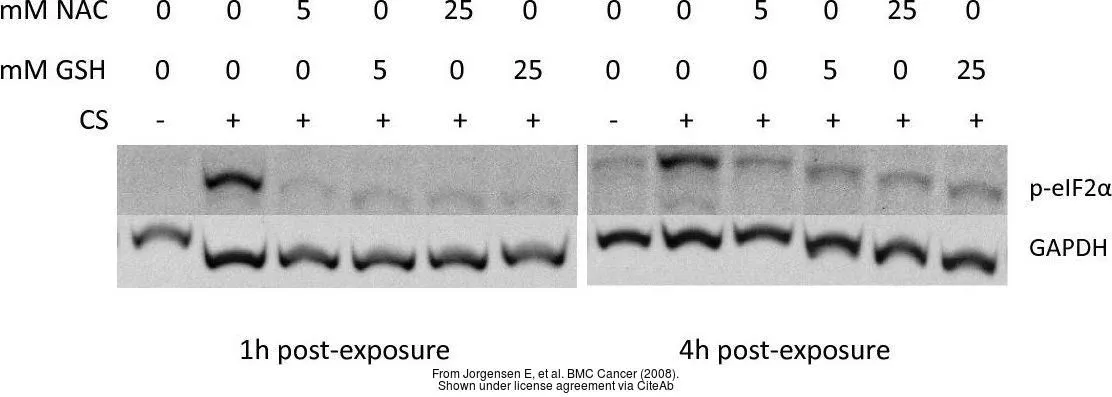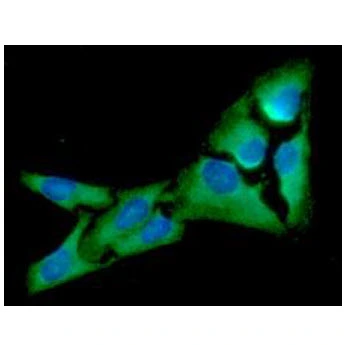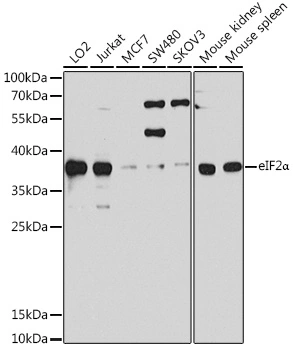![Rabbit anti EIF2alpha [pS51] phosphospecific polyclonal antibody. Left: Image shows immunocytochemical analysis of EIF2alpha [pS51] in rat brain (mediodorsal neocortex) sections following traumatic axonal injury (TAI) (24 h). Control (prior to injury induction) shows low basal levels of EIF2alpha [pS51]. Right: Image shows double labeling of APP (red) and EIF2alpha [pS51] (green) in neurons subjected to traumatic axonal injury (TAI). Inset (above): higher magnification of neuronal soma with TAI. EIF2alpha [pS51] immunofluorescence is localized in cytoplasm of neuronal cell body. Rabbit anti EIF2alpha [pS51] phosphospecific polyclonal antibody. Left: Image shows immunocytochemical analysis of EIF2alpha [pS51] in rat brain (mediodorsal neocortex) sections following traumatic axonal injury (TAI) (24 h). Control (prior to injury induction) shows low basal levels of EIF2alpha [pS51]. Right: Image shows double labeling of APP (red) and EIF2alpha [pS51] (green) in neurons subjected to traumatic axonal injury (TAI). Inset (above): higher magnification of neuronal soma with TAI. EIF2alpha [pS51] immunofluorescence is localized in cytoplasm of neuronal cell body.](https://www.genetex.com/upload/website/prouct_img/normal/GTX24837/EIF2A-phospho-Ser52-antibody_ICCIF_GTX24837-1_w_23060722_500.webp)
Rabbit anti EIF2alpha [pS51] phosphospecific polyclonal antibody. Left: Image shows immunocytochemical analysis of EIF2alpha [pS51] in rat brain (mediodorsal neocortex) sections following traumatic axonal injury (TAI) (24 h). Control (prior to injury induction) shows low basal levels of EIF2alpha [pS51]. Right: Image shows double labeling of APP (red) and EIF2alpha [pS51] (green) in neurons subjected to traumatic axonal injury (TAI). Inset (above): higher magnification of neuronal soma with TAI. EIF2alpha [pS51] immunofluorescence is localized in cytoplasm of neuronal cell body.
eIF2 alpha (phospho Ser51) antibody
GTX24837
ApplicationsImmunoFluorescence, Western Blot, ImmunoCytoChemistry, ImmunoHistoChemistry
Product group Antibodies
TargetEIF2S1
Overview
- SupplierGeneTex
- Product NameeIF2 alpha (phospho Ser52) antibody
- Delivery Days Customer9
- ApplicationsImmunoFluorescence, Western Blot, ImmunoCytoChemistry, ImmunoHistoChemistry
- CertificationResearch Use Only
- ClonalityPolyclonal
- ConjugateUnconjugated
- Gene ID1965
- Target nameEIF2S1
- Target descriptioneukaryotic translation initiation factor 2 subunit alpha
- Target synonymsEIF-2, EIF-2A, EIF-2alpha, EIF2, EIF2A, eukaryotic translation initiation factor 2 subunit 1, eIF-2-alpha, eIF2-alpha, eukaryotic translation initiation factor 2, subunit 1 alpha, 35kDa
- HostRabbit
- IsotypeIgG
- Protein IDP05198
- Protein NameEukaryotic translation initiation factor 2 subunit 1
- Scientific DescriptionThe translation initiation factor EIF2 catalyzes the first regulated step of protein synthesis initiation, promoting the binding of the initiator tRNA to 40S ribosomal subunits. Binding occurs as a ternary complex of methionyl-tRNA, EIF2, and GTP. EIF2 is composed of 3 nonidentical subunits, the 36-kD EIF2-alpha subunit (EIF2S1), the 38-kD EIF2-beta subunit (EIF2S2; MIM 603908), and the 52-kD EIF2-gamma subunit (EIF2S3; MIM 300161). The rate of formation of the ternary complex is modulated by the phosphorylation state of EIF2-alpha (Ernst et al., 1987 [PubMed 2948954]).[supplied by OMIM, Feb 2010]
- Storage Instruction-20°C or -80°C,2°C to 8°C
- UNSPSC12352203
References
- ER Stress-Induced Sphingosine-1-Phosphate Lyase Phosphorylation Potentiates the Mitochondrial Unfolded Protein Response. Yildirim AD et al., 2022 Oct, J Lipid ResRead more
- Cigarette smoke induces endoplasmic reticulum stress and the unfolded protein response in normal and malignant human lung cells. Jorgensen E et al., 2008 Aug 11, BMC CancerRead more


![IHC-P analysis of human colon carcinoma tissue using GTX25369 eIF2 alpha antibody [EIF2a]. Right : Primary antibody Left : Negative control without primary antibody Antigen retrieval : 10mM sodium citrate (pH 6.0), microwaved for 8-15 min Dilution : 1:20](https://www.genetex.com/upload/website/prouct_img/normal/GTX25369/GTX25369_1277_IHC-P_w_23060722_469.webp)

![WB analysis of HeLa cell extracts with/without Calyculin A (100 nM, 37oC, 30 min) treatment after serum-starvation overnight or TNF-alpha (20 ng/ml, 37oC, 30 min) treatment using GTX00965 eIF2 alpha (phospho Ser51) antibody [GT1203]. Dilution : 1:1000 Loading : 25microg](https://www.genetex.com/upload/website/prouct_img/normal/GTX00965/GTX00965_20200327_WB_1_w_23053121_538.webp)
![WB analysis of HEK293T cells transfected with eIF2 alpha plasmid (Right) or empty vector (Left) for 48 hrs using GTX84578 eIF2 alpha antibody [3H7]. Loading : 5 ug per lane](https://www.genetex.com/upload/website/prouct_img/normal/GTX84578/GTX84578_4475_WB_w_23061420_557.webp)
![ICC/IF analysis of COS7 cells transiently transfected with eIF2 alpha plasmid using GTX84579 eIF2 alpha antibody [3H4].](https://www.genetex.com/upload/website/prouct_img/normal/GTX84579/GTX84579_1138_ICCIF_w_23061420_818.webp)
![IHC-P analysis of human prostate tissue using GTX84582 eIF2 alpha antibody [1H1]. Antigen retrieval : Heat-induced epitope retrieval by 10mM citrate buffer, pH6.0, 100oC for 10min.](https://www.genetex.com/upload/website/prouct_img/normal/GTX84582/GTX84582_2894_IHC-P_w_23061420_871.webp)

